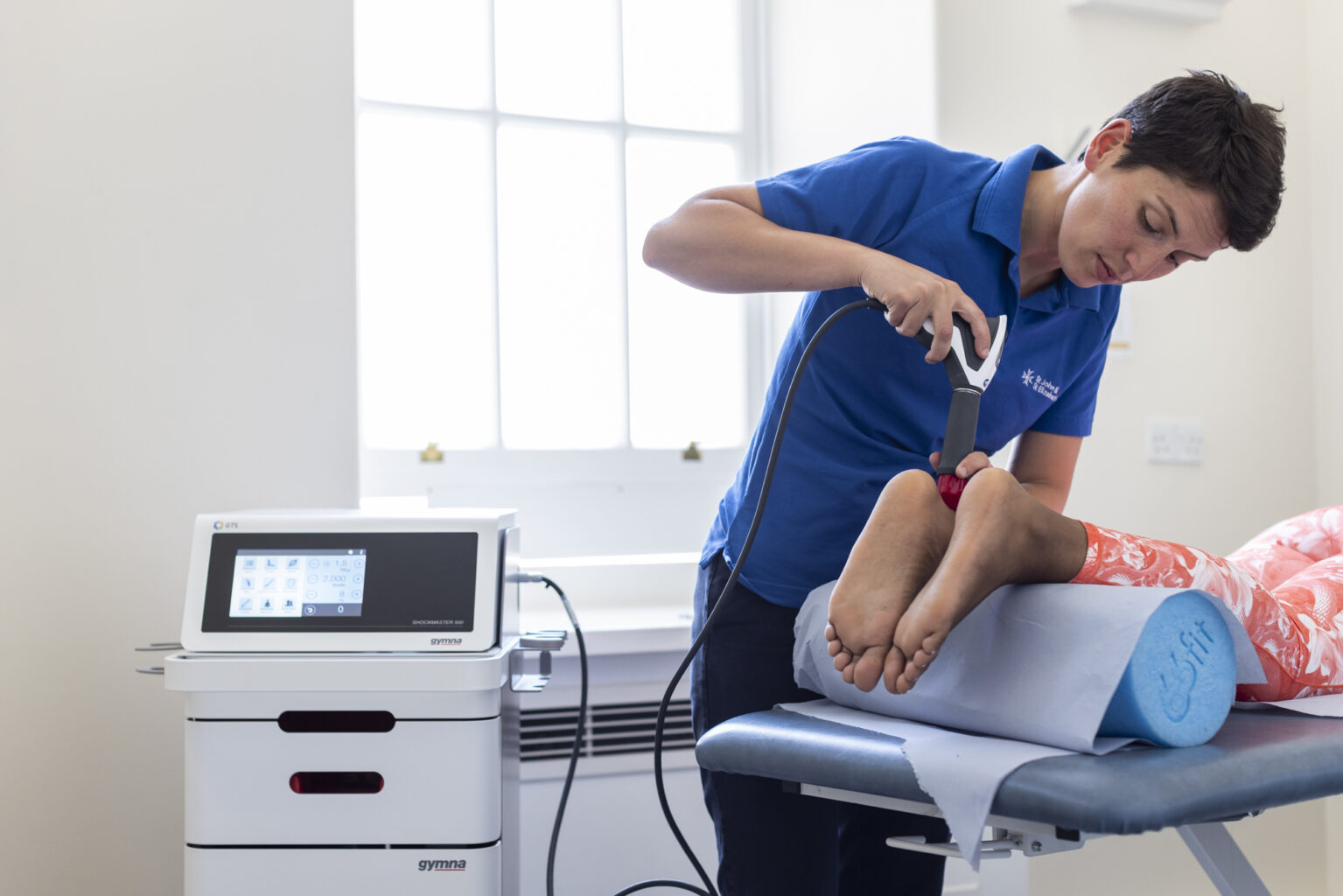Contact number: 020 7806 4010
What is shockwave therapy?
Shockwave therapy is a non-invasive treatment that uses high-energy sound waves to target areas of pain and promote healing. The sound waves are delivered through the skin to the affected area, stimulating the body’s natural repair processes by increasing blood flow, reducing inflammation, and encouraging the regeneration of damaged tissue.
This therapy is particularly beneficial for individuals experiencing chronic pain caused by musculoskeletal conditions or long-standing tendon issues. It is commonly used to treat:
- Plantar fasciitis (Plantar fasciopathy)
- Heel spurs
- Achilles Tendon (Achilles tendinopathy or tendonitis)
- Calcium deposits in your shoulder rotator cuffs (Shoulder calcific tendinosis or calcific tendonitis)
- Tennis elbow (Lateral epicondylitis)
- Golder’s elbow (Medial Epicondylitis)
- Jumper’s knee (Patella tendinopathy)
- Hip pain (caused by greater trochanteric pain syndrome)
- Inflammation in the tendons at the back of your thigh (Proximal hamstring tendinopathy)
At St John & St Elizabeth Hospital, shockwave therapy offers a safe and effective solution for patients seeking to relieve pain and improve mobility without surgery. Our expert physiotherapists recommend this treatment when other options, such as physiotherapy and medication, have not provided sufficient relief. The procedure is quick, with minimal downtime, helping you get back to your daily activities as soon as possible.
To ensure patient safety and that shockwave is used appropriately, each patient will require an initial assessment with an MSK physiotherapist before commencing with the treatment.
Shockwave Therapy Cost
Price per session: £140
Shockwave therapy costs £140 per session or £395, for a package of three. As with any type of physiotherapy, you will need to receive multiple sessions to feel the comprehensive benefits of treatment.
How to pay for your treatment
If you’re… paying for yourself
Did you know you don’t need private medical insurance to come to St John & St Elizabeth Hospital? As a self-pay patient, you can access safe, outstanding quality health care at times to suit you.
For scans and tests, as well as to see most consultants, you’ll still need to be referred by a medical professional like your GP, but as a self-pay patient, the process is more straightforward. You won’t need authorisation from an insurance provider, and you’ll have greater choice of therapist and appointment times.
If you’re… insured
St John & St Elizabeth Hospital is approved by all major medical insurance companies. If you have a personal private health insurance policy, or your company provide it for you, you can use it to pay for your care from your initial consultation through to treatment, surgery and aftercare such as physiotherapy. Not all private health insurance plans cover the same things. It’s very important to check exactly what you are covered for with your insurance provider.
FAQs about Shockwave Therapy
If you have persistent pain or stiffness after an injury, it’s important to see a doctor for an assessment. Initial treatment usually includes physiotherapy and, in some cases, injections to reduce pain and inflammation. If symptoms continue despite these treatments, your doctor may recommend shockwave therapy, a non-invasive treatment performed by a specially trained physiotherapist.
You must stop taking anti-inflammatory (NSAID) medications, such as ibuprofen, for at least two weeks before starting treatment and throughout the course. If you’re unsure whether your medication contains NSAIDs, check with your doctor, nurse, or pharmacist. On the day of treatment, you can eat and drink as normal and should wear comfortable clothing that allows easy access to the treatment area.
Your therapist will begin by locating the painful area through palpation. A water-based gel will then be applied to the skin, and a handheld probe will be placed on the affected area. The machine delivers sound waves that increase blood flow and stimulate healing. The treatment usually lasts about five minutes and should feel like a strong vibration rather than pain.
Most patients require three to five sessions, with each session scheduled weekly and no more than two weeks apart. Over time, your body’s tolerance to the treatment will improve, and tendon strength will increase, leading to a reduction in pain. Some people notice immediate relief, but the full benefits are usually seen after completing the treatment course, typically around three months.
You can continue your day as normal, though mild aching is common. To manage discomfort, take paracetamol before and after your session, but avoid NSAIDs such as ibuprofen, aspirin, or diclofenac, as well as ice packs, since these can interfere with the body’s healing response. After completing the course of treatment, your referring doctor will review your progress.
St John & St Elizabeth Hospital is located in St John’s Wood (NW8), a well-connected area of North West London. We’re close to Hampstead (NW3) and Kilburn (NW6), making us accessible to patients across the region.
By Tube:
- St John’s Wood station (Jubilee Line) is just a 5-minute walk from the hospital.
- Finchley Road (NW3) and Kilburn stations (NW6) on the Jubilee Line provide excellent connections.
By Bus:
- Wellington Road: Routes 13, 46, 82, and 113 stop near St John’s Wood Underground Station, just a short walk from the hospital.
- Circus Road: Routes 46 and 187 stop close to the hospital’s Circus Road entrance.
- Abbey Road: Routes 139 and 189 stop near the junction where Grove End Road becomes Abbey Road, providing easy access.
Major Roads:
If you’re travelling from NW3 or NW6, main routes such as Finchley Road or Kilburn High Road offer a direct approach to the hospital.
Our location ensures convenient travel for patients from across London, particularly those in NW8, NW3, and NW6 postcodes.

